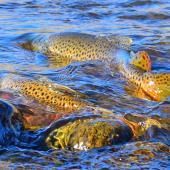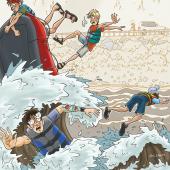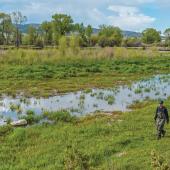Lower Yellowstone: Big & Bountiful
A lesser-known section of the Yellowstone.
At Livingston, the Yellowstone turns from a northerly course through Paradise Valley to an easternly one across the plains. It flows over 400 miles to its eventual end at the confluence with the Missouri River in western North Dakota. As one heads downstream from Livingston, the picture changes from the intimate beauty of Paradise Valley to the vast, sprawling prairie-valley of what anglers consider the “Lower Yellowstone,” or the 75-mile section from Livingston to Columbus. While fishing this stretch, one has the opportunity to catch wild trout, and take in some breathtaking scenery. Downstream from Livingston, the vistas of Sheep Mountain, the Crazy Mountains, and the northern front of the Beartooth Mountains all provide a stunning backdrop to some excellent trout fishing.
Access
Finding public fishing-access sites, which are scattered about every 10 miles on the river, is not difficult. I-90 and its accompanying frontage roads closely parallel the river, making this section easily-accessible for both float- and wade-fishermen alike.
Flows
If one is looking for the “ideal flows,” one must consider a range. As the water drops from its annual high-water mark, it eventually begins to clear, generally around 6,000 to 8,000cfs. 6,000 is the high end of the ideal range, and flows above 8,000 create some fast and heavy currents. The low end depends on water temperatures. Low flows with cool water temperatures are ideal, yet post-runoff water temperatures tend to rise with the summer season. High water temps tend to turn the fish off, so any low-flow periods when the water is below 65 degrees are ideal. To find flow and water-temperature data, go to the USGS website and look at the Livingston gauge on the Yellowstone.
When to Go
The fishing season is generally looked at as two separate periods: pre-runoff and post-runoff. Pre-runoff occurs just after ice-out, which is usually in March and April. The flows are low, the water is clear and cold, and the fishing can be great. The weather, however, can be wintry. Runoff, on average, runs through May and June. As runoff subsides, the muddy waters clear and flows begin to drop. Wade opportunities are somewhat limited for a couple of weeks at this point due to the remaining high water, but the best fishing of the summer occurs after this drop.
Fish
This section of the Yellowstone has good populations of rainbow and brown trout, as well as the ubiquitous, and native mountain whitefish. In addition, there are small populations of native Yellowstone cutthroat trout, and even a few non-native brook trout. These fish can be caught with streamers, dries, and nymphs, depending on the flows and time of year. In addition to the fish, keep an eye out for bald eagles, golden eagles, osprey, deer, otters, bears, turkeys, and even an occasional moose roaming the banks.
Roe vs. Wade
To fish the majority of the Yellowstone, most anglers float between access points, float- and wade-fishing along the way. Wade-fishing without a boat is also an option at many of the fishing access points. According to Montana’s stream-access law, the streambed below the normal high-water mark is fair game to anglers, so any public bridge or access-point is a “trailhead” to explore and fish the river.
Regs
Catch-and-release fishing is encouraged, yet legally an angler can harvest up to five trout per day (only 1 over 18 inches; only 1 cutthroat). Consult the regulations for current restrictions or closures.
Getting There
Big Timber sits smack-dab in the middle of this stretch, and is a great place from which to attack the river. It’s located 35 miles downstream from Livingston, and 35 miles upstream of Columbus. To get there, simply take I-90 east from Livingston. Supplies and shuttles can be purchased in Big Timber.
Adam Wagner owns Sweetcast Angler in Big Timber. Call the shop at (406) 932-4469.












